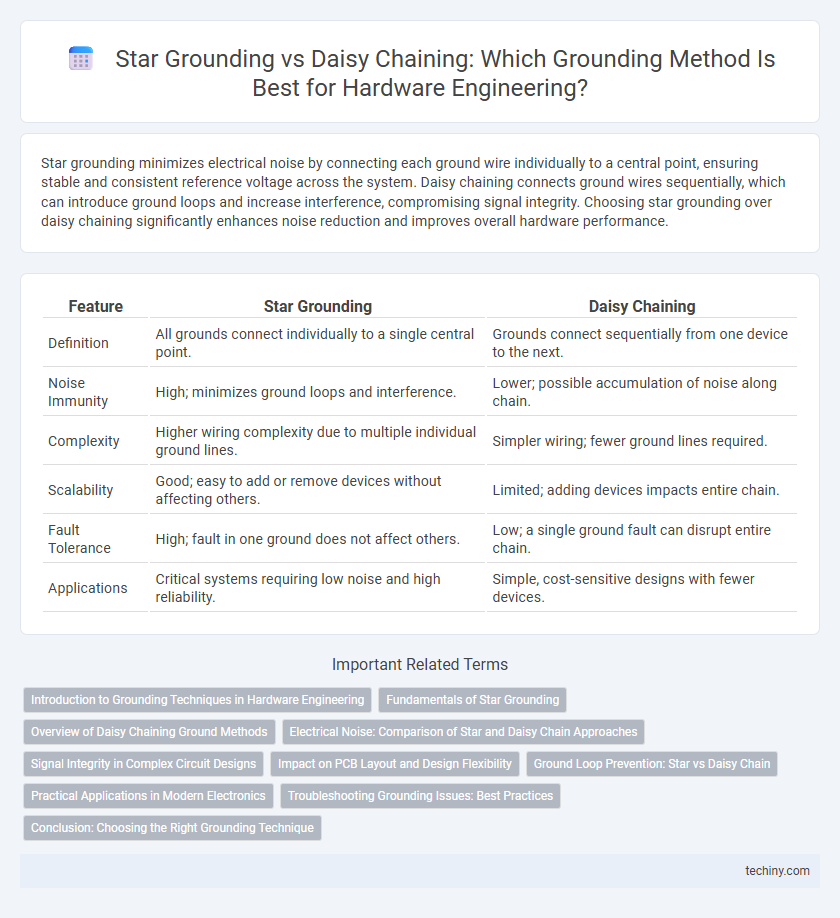Star grounding minimizes electrical noise by connecting each ground wire individually to a central point, ensuring stable and consistent reference voltage across the system. Daisy chaining connects ground wires sequentially, which can introduce ground loops and increase interference, compromising signal integrity. Choosing star grounding over daisy chaining significantly enhances noise reduction and improves overall hardware performance.
Table of Comparison
| Feature | Star Grounding | Daisy Chaining |
|---|---|---|
| Definition | All grounds connect individually to a single central point. | Grounds connect sequentially from one device to the next. |
| Noise Immunity | High; minimizes ground loops and interference. | Lower; possible accumulation of noise along chain. |
| Complexity | Higher wiring complexity due to multiple individual ground lines. | Simpler wiring; fewer ground lines required. |
| Scalability | Good; easy to add or remove devices without affecting others. | Limited; adding devices impacts entire chain. |
| Fault Tolerance | High; fault in one ground does not affect others. | Low; a single ground fault can disrupt entire chain. |
| Applications | Critical systems requiring low noise and high reliability. | Simple, cost-sensitive designs with fewer devices. |
Introduction to Grounding Techniques in Hardware Engineering
Star grounding involves connecting all ground points to a single central node, minimizing ground loops and reducing electromagnetic interference (EMI) in complex hardware systems. Daisy chaining links ground points sequentially, which can introduce voltage drops and noise, making it less effective for high-frequency or sensitive electronic circuits. Optimal grounding techniques in hardware engineering depend on system complexity and EMI susceptibility, with star grounding favored for critical signal integrity.
Fundamentals of Star Grounding
Star grounding is a grounding technique where all ground connections converge at a single central point, minimizing ground loops and noise interference in hardware circuits. This method ensures a low-impedance path for return currents by preventing multiple ground return paths that can cause voltage fluctuations and signal integrity issues. Compared to daisy chaining, star grounding provides superior noise immunity and improved electromagnetic compatibility in complex electronic systems.
Overview of Daisy Chaining Ground Methods
Daisy chaining ground methods connect multiple devices in series, creating a continuous ground path that simplifies wiring and reduces overall cable length. This configuration, common in hardware engineering, can introduce ground loop noise and voltage drops, impacting signal integrity in sensitive circuits. Proper design and impedance control are crucial to maintaining reliable grounding and minimizing interference in daisy chained systems.
Electrical Noise: Comparison of Star and Daisy Chain Approaches
Star grounding significantly reduces electrical noise by providing each device with a direct, low-impedance path to a common ground point, minimizing ground loops and interference. In contrast, daisy chaining grounds devices sequentially, increasing the risk of voltage drops and noise coupling due to shared return paths. This makes star grounding the preferred method in hardware engineering for maintaining signal integrity and reducing electromagnetic interference.
Signal Integrity in Complex Circuit Designs
Star grounding in hardware engineering minimizes ground loop interference by connecting all ground points to a single reference node, significantly enhancing signal integrity in complex circuit designs. Daisy chaining, although simpler to implement, often introduces ground potential differences along the chain, which can cause voltage drops and noise, degrading signal quality. Ensuring optimal signal integrity requires careful selection between star grounding and daisy chaining, with star grounding preferred for high-speed, sensitive circuits demanding low noise and stable reference voltages.
Impact on PCB Layout and Design Flexibility
Star grounding in hardware engineering improves PCB layout by minimizing ground loop interference and providing clear, centralized grounding points, which enhances signal integrity and noise reduction. Daisy chaining simplifies trace routing but introduces potential ground loops and voltage drops that can degrade performance and limit design flexibility. Choosing star grounding enables more precise control over electromagnetic interference (EMI) and supports complex, high-speed circuit layouts more effectively than daisy chaining.
Ground Loop Prevention: Star vs Daisy Chain
Star grounding architecture minimizes ground loops by providing a single, centralized grounding point, ensuring all components share a common reference and reducing interference. Daisy chaining connects grounds sequentially, increasing the risk of ground loops due to potential voltage differences along the chain. In hardware engineering, star grounding is preferred for critical systems requiring enhanced noise immunity and precise signal integrity.
Practical Applications in Modern Electronics
Star grounding offers superior noise reduction by providing a single reference point for all circuit grounds, making it ideal for sensitive analog and digital systems in modern electronics such as audio equipment and precision sensors. Daisy chaining, while simpler and cost-effective, is commonly used in lower-frequency or less noise-sensitive applications like basic power distribution and LED lighting arrays. Practical implementation often balances signal integrity requirements with design complexity to optimize performance in hardware engineering projects.
Troubleshooting Grounding Issues: Best Practices
Star grounding minimizes noise and interference by providing a single, central ground point, simplifying troubleshooting by isolating ground loops effectively. Daisy chaining can complicate fault detection due to cascading effects in the ground path, making intermittent grounding issues harder to trace. Best practices prioritize star grounding for improved signal integrity and streamlined diagnostics in hardware engineering.
Conclusion: Choosing the Right Grounding Technique
Star grounding offers superior noise reduction and enhanced signal integrity by providing a single, centralized ground point, ideal for complex hardware systems with sensitive components. Daisy chaining, while simpler and cost-effective, may introduce ground loops and increased interference, making it less suitable for high-performance or noise-sensitive applications. Selecting the appropriate grounding technique depends on system complexity, sensitivity to noise, and overall reliability requirements in hardware engineering.
Star grounding vs Daisy chaining Infographic

 techiny.com
techiny.com